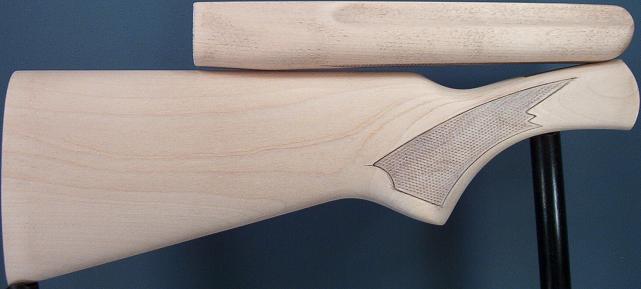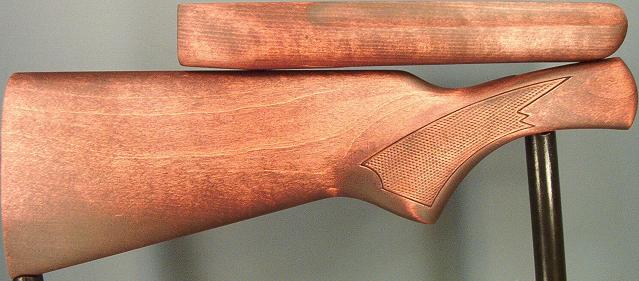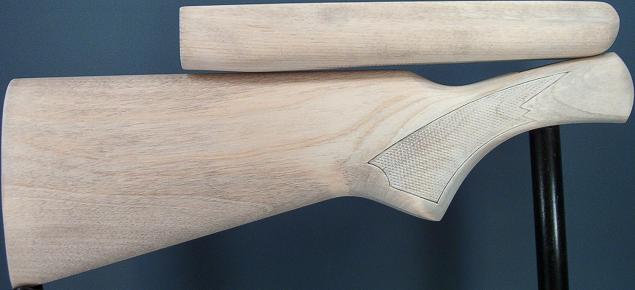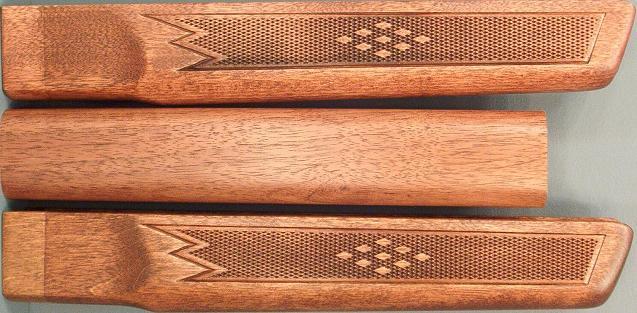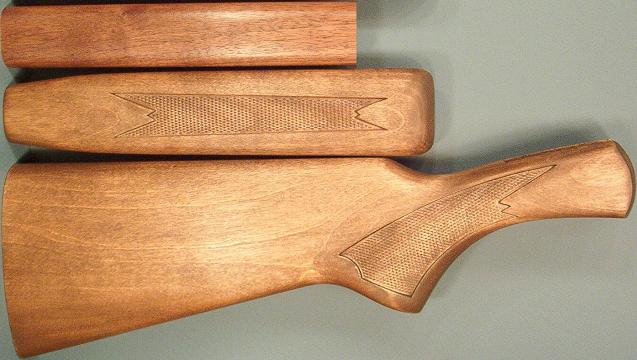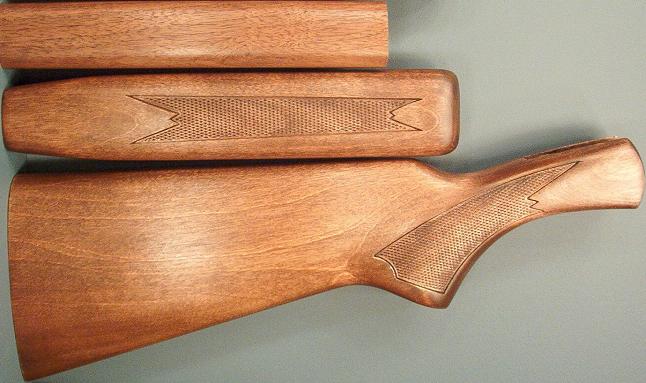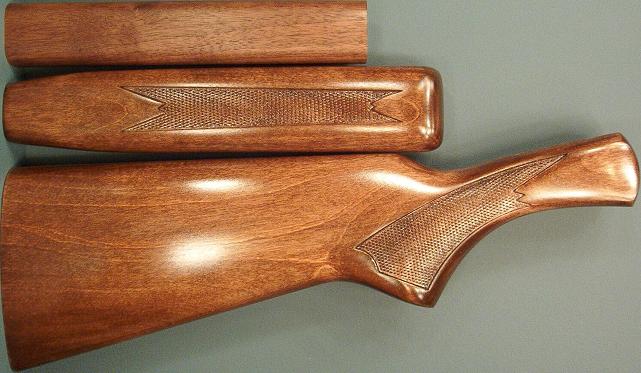Many gun stocks are made from Maple or other woods that do not accept stain evenly which results in a very blotchy and unsatisfactory finish. In an effort to produce a uniform color on this type of wood, some manufacturers first apply a pre-finish coating to prevent blotching. In an effort to produce a finish that appears as Walnut, many manufacuturers apply what appears to be a lacquer finish that contains a redish-brown stain which also helps prevent blotching. These factory finishes reveal very little grain texture as can be seen in the photos below of the Winchester Model 37A Shotgun serial number C523878:
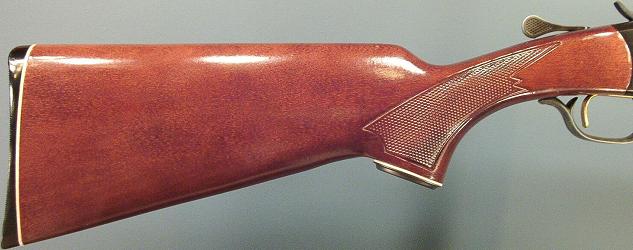
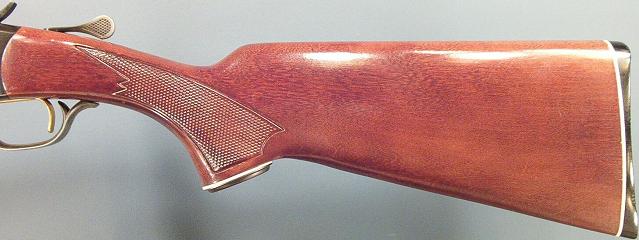
The objective of this demonstration is to select stain(s) for Maple stocks to appear as Walnut and reveal grain texture without blotching. To prevent any possible compatibility issues, the stains and finishes of a single manufacturer will be considered; in this case Minwax. The product directions are followed precisely.
Refer to Wood Staining for more information on staining wood.
Blotching Demonstration
The photo below shows the Maple stock of Winchester Model 37A Shotgun serial number C074434 after being stripped, sanded with 320 grit sandpaper, and the grain raised:
The photo below is of the above stock after being stained with Minwax Red Mahogany (225) penetrating stain, This demonstrates the serious blotching that occurs when Maple is stained with penetrating stain:
Notice the uneven absorption of stain as indicated by the dark blotchy areas, especially at the end grain. Once wood has been stained with penetrating stain, especially after the grain is raised, it is extremely difficult to remove the stain and is impossible to remove all of it.
The photo below shows the above stock after being stripped using mineral spirits, lacquer thinner, three types of stripper with bleach and vinegar to remove as much of the stain as possible:
Note that stain remains, especially at the end grain.
Staining Maple To Appear As Walnut Demonstration
As demonstrated in Wood Staining, Maple is poor at absorbing stain when sanded smoothly and is poor at absorbing stain uniformly. Since stain absorbtion is maximized when wood grain is raised and stain uniformity is optimal when gel stains are used, the wood grain will be raised and a gel stain(s) will be used to to produce a finish that appears as Walnut.
The photo below shows a section of American Black Walnut between two Maple forends. The American Black Walnut has been cut and routed to the approximate size and shape of a typical forend, sanded with 320 grit sandpaper, and then finished with two applications of Minwax Antique Oil Finish (Linseed Oil/Varnish). The two Maple forends were stripped, sanded with 180 grit sandpaper, the grain raised, and then stained. The top forend was first stained with Minwax Brazilian Rosewood (608) gel stain and the bottom forend was first stained with Minwax Walnut (606) gel stain. The far left portion of these forends show this first stain application. Since the top forend needed to be slightly browner to match the Walnut, it was then stained with Minwax Walnut (606) gel stain (except for the far left portion). Since the bottom forend needed to be slightly redder to match the Walnut, it was then stained with Minwax Brazilian Rosewood (608) gel stain (except for the far left portion).
Notice that the bottom forend, that was first stained with the Walnut (606) gel stain and then stained with the Brazilian Rosewood (608) stain, seems to match the finished Walnut the best. The only issue with the above results are that the areas where the longer wood fibers were extended after raising the grain caused those areas to appear slightly blotchy. This can be remedied by very light but thorough sanding with 320 grit sandpaper after the grain has been raised.
Staining Maple Stock To Appear As Walnut
Based on the above demonstrations, the preparation and stains required to produce a Walnut finish on a Maple stock follow:
1. Sand with 180 grit sandpaper to promote stain absorbtion.
2. Raise wood grain to promote stain absorbtion.
3. Sand very lightly and thoroughly with 320 grit sandpaper to remove extended wood fibers.
4. Stain with Walnut (606) gel stain to produce Walnut brown color.
5. Stain with Brazilian Rosewood (608) gel stain to acquire Walnut reddish tint.
The photo below shows the Maple stock of Winchester Model 37A Shotgun serial number C074434 after being sanded with 180 grit sandpaper, the grain raised, and then lightly but thoroughly sanded with 320 grit sandpaper:
The photo below shows the finished American Black Walnut section above the above Maple stock after staining with the Walnut (606) gel stain:
The photo below shows the finished American Black Walnut section above the above Maple stock after staining with the Brazilian Rosewood (608) gel stain:
The photo below shows the finished American Black Walnut section above the above Maple stock after finishing with 5 applications of Antique Oil Finish (Linseed Oil/Varnish):
Five applications of the Antique Oil Finish (Linseed Oil/Varnish) were applied to match the gloss and texture of the finish applied by the factory on these guns as shown in the photo below of Winchester Model 37A Shotgun serial number C523878:
The photo below shows Winchester Model 37A Shotgun serial number C074434 after assembly:
For comparison, the photo below shows Browning 2000 Gas Autoloading Shotgun serial number 25120 having a French Walnut stock:
